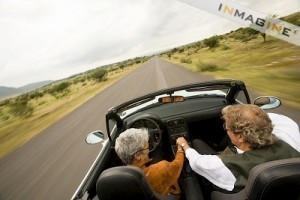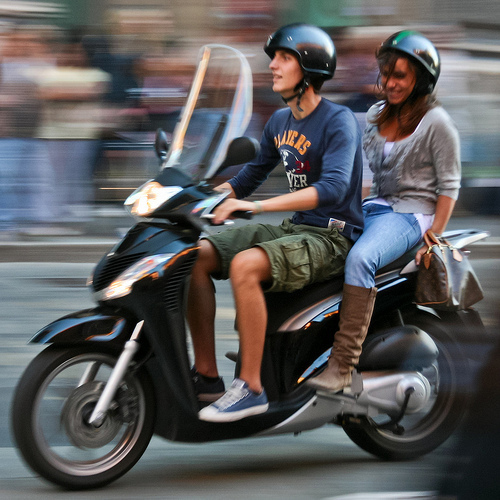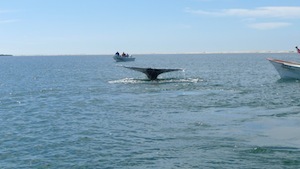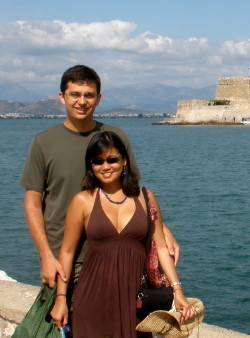Rolf Potts's Blog, page 135
February 23, 2011
Vagabonding Case Study: Dina and Ryan
Age: Both 30
Hometown: Java, Indonesia and Ontario, Canada
Quote: "You can design your own life for yourself based on who you want to be."
How did you find out about Vagabonding, and how did you find it useful before and during the trip? We've been checking out the website as we travelled for various tips.
How long were you on the road? We've been on the road since April 2009 and are still going.
Where all did you go? USA, Spain, Portugal, Andorra, France, Monaco, Gibraltar, Italy, Vatican City, Belgium, Luxembourg, Netherlands, Germany, Sweden, Denmark, Norway, Greece, Turkey, Egypt, UAE, Australia, Indonesia, New Zealand, and Fiji.
What was your job or source of travel funding for this journey? Ryan was able to negotiate a remote work agreement with his employer so he continued to work as we traveled.
Did you work or volunteer on the road? Just Ryan's remote work
Of all the places you visited, which was your favorite? New Zealand. The natural beauty is incredible there. Our favourite place in New Zealand is Milford Sound in the South Island.
Was there a place that was your least favorite, or most disappointing, or most challenging? We loved Brussels, but the Manneken Pis has got to be the most disappointing landmark we've seen. We thought it was going to be bigger, more interesting, or at least remarkable in some way. Turns out the famous emblem of Brussels is a little statue in a fountain like you might see in someone's backyard.
Did any of your pre-trip worries or concerns come true? Did you run into any problems or obstacles that you hadn't anticipated? Nothing major. The worst incident was being chased by a creepy looking man in Lisbon in a dark and empty street around midnight, but we managed to get away. In the Island of Crete, the hotel's maid stole our souvenirs, which was strange since they weren't worth much, just for sentimental value really.
Which travel gear proved most useful? Least useful?
Laptop, easily the most useful.
Least useful was the expensive hiking sandals we brought along (ended up mailing them back home since we couldn't bear to throw them away). One pair of good shoes is enough.
What are the rewards of the vagabonding lifestyle?
Freedom, challenge, and friendship
What are the challenges and sacrifices of the vagabonding lifestyle? Delaying having kids and having to deal with expectations of family and friends to have a "normal life", whatever that means. Dina can't have a mobile career that matches with her previous education, which was Chemistry.
Leaving family and friends behind means we miss out some of the important events. Of course for the most important ones, we try our best to get home. We also lose touch with the day-to-day which makes it harder to relate to the folks back at home. We aren't up on the latest fads anymore.
What lessons did you learn on the road? You don't have to follow people's expectations, you can design your own life for yourself based on who you want to be.
Most of what you know about the world is probably wrong, and coloured by prejudice.
How did your personal definition of "vagabonding" develop over the course of the trip? Before we were thinking of spending 1-2 years of backpacking, now we are aiming to be permanent travelers. Instead of running through our savings, we are trying to make this lifestyle sustainable.
If there was one thing you could have told yourself before the trip, what would it be? To exercise regularly, to be stronger and have better stamina on the road.
Any advice or tips for someone hoping to embark on a similar adventure? Start saving money, give yourself a year to wrap up your life and prepare the travel necessities. Don't keep your possessions especially house/apartment and cars, because it will be too expensive to have to support them back home. Cut the ties and go for it!
When and where do you think you'll take your next long-term journey?
In a few weeks heading down to the Caribbean and Central America, then who knows.
Twitter: vagabondquest
Website: www.vagabondquest.com
Are you a Vagabonding reader planning, in the middle of, or returning from a journey? Would you like your travel blog or website to be featured on Vagabonding Case Studies? If so, drop us a line at casestudies@vagabonding.net and tell us a little about yourself.
February 22, 2011
Rules for romance: single female travelers becoming pairs?
 There's a lot of you-go-grrl-empowerment articles on the web and in travel magazines about women traveling on their own, toting their own backpacks and having exciting adventures. The general themes of these articles usually has to do with being brave and feeling safe walking the streets at night, making friends with locals, avoiding singles supplements or suspicious glances when you try to book a tour or go on a cruise. Very few of them deal with how you take the first steps into new-couplehood while you're traveling, particularly with someone who's not of your culture.
There's a lot of you-go-grrl-empowerment articles on the web and in travel magazines about women traveling on their own, toting their own backpacks and having exciting adventures. The general themes of these articles usually has to do with being brave and feeling safe walking the streets at night, making friends with locals, avoiding singles supplements or suspicious glances when you try to book a tour or go on a cruise. Very few of them deal with how you take the first steps into new-couplehood while you're traveling, particularly with someone who's not of your culture.
It's pretty easy to find hook-up partners at hostels and budget hotels: any backpacker worth their salt can find another backpacker to share a hammock with, and some people seem to hit the road with that purpose in mind–here, I'm thinking of the British guy in the film Love Actually who goes to America because he knows his accent will make him more appealing to US women. But what about when you find that the hooking up has gone further than just a one-night stand, and you might actually have a long-term relationship on your hands? What are the next steps for long-term traveling girls?
I know this sounds incredibly obvious, but the first thing you should do when you realize your relationship is becoming serious is sit down and talk to your partner about whether or not they want to travel with you or whether or not you want to stay put with them — it's a fairly important question, one that could put an abrupt end to your relationship when you want to go to Puerto Rico as you've been planning for the past year, and he's just got a promotion at his job in Australia and there isn't really room for negotiation.
If they decide they want to come with you, probably the next thing to discuss is: for how long? Do you want to maintain a long-distance relationship spattered with months of traveling together, or does your partner want to sell up and join you on your nomadic journeying?
If you decide you want to stay with them, the most important thing to investigate is probably going to be visa options. In Australia, you can get a residency visa if you're in a de facto relationship (you don't have to get married)…but you need to have physical proof that you've been together at least a year and it costs about $2000.
If your partner is from a different culture, be aware that you're not just figuring out new relationship boundaries, but you're doing it with cultural assumptions about what relationships are that most people never talk about. For example, when you say "I love you" it might mean something completely different to what your neighbor means…you might mean "I plan to commit to you and have lots of children" and your neighbor might mean "I think you're much better than anyone else I can find." Small but subtle differences.
As with any relationship, your safety and security are important. When you're traveling, you might tend to loosen up your restrictions or put more faith in humanity as a whole, both admirable habits. However, it's important to ensure that your partner treats you respectfully and values you as a person: nobody should ever hit you, call you malicious names, undermine you, isolate you from your friends, or threaten you, even if they are from a different culture. If any of those things start to happen, they're not cultural differences: they're proof that you could be in danger, and it's important for you to leave it.
Hopefully these tips are a good place to start for someone just starting a relationship as a longterm voyager…and might help people remember that there can be more to someone cute that you meet than a night in the sack.
February 21, 2011
Eric Weiner on the limitations of luxury hotels
"Like embassies, five-star hotels go to great lengths to isolate, and insulate, themselves from the host country. It is possible to spend many days at a five-star hotel engaged in all sorts of productive activities — holding meetings, eating meals, exercising, getting married, watching movies — without ever stepping foot in the actual country where you allegedly find yourself. This is no accident, of course. The hotel owners want you to stay put and spend money."
–Eric Weiner, "Travel That Counts — or My Passport Is Better-Stamped Than Yours", World Hum, May 26, 2009
February 19, 2011
Planning an Itinerary Around a Budget
We've mentioned several times before how common budget questions are when talking about long-term travel. Unless you've got a means for making money as you travel – whether through a web-based business or by taking odd jobs along the way – you'll need to save up whatever you plan to live off of before you leave home. It's not surprising this is a challenge for many people.
If you're among the budget-challenged, then, does this mean you can't take a RTW trip? Some have discussed taking out loans in order to travel (a practice frowned upon by Vagablogging readers), but if that's not an appealing option you aren't necessarily stuck at home.
By choosing an itinerary based around how much money you'll spend in each place, you can make your travel budget last much longer. Yes, this can mean not including big-name destinations like the ones in Europe, but if the point is to travel and you aren't so focused on where you travel, it's a much more budget-friendly option. A recent BootsnAll article listed 5 countries you can visit for under $500, including Thailand, Vietnam, and Colombia, and another article featured 8 places that are cheap to visit once you get there.
Another thing to be aware of is that no matter where you go there are often free attractions and activities you can do – some of them will be among the main tourist sights in a place, while others will help you get off that beaten path we're all so used to hearing about. This article listed 10 free ways to discover a destination, including finding the free museums, free walking tours, free outdoor concerts and movies, or the free festivals going on.
The bottom line is that not only do you not have to go into deep debt in order to take a long-term trip, you also don't have to save up tens of thousands of dollars to make it happen, either. This month's Round the World Ticket Watch newsletter focuses on budget-friendly destinations you can add to your RTW itinerary, so sign up in order to get that delivered to your inbox.
February 18, 2011
"Road-test" a relationship by traveling together?
"I have found out there ain't no surer way to find out whether you like people or hate them than to travel with them."
-Tom Sawyer Abroad, by Mark Twain

Couple riding a scooter in Bologna, Italy. Photo: H Matthew Howarth / Flickr
Naturally, we put up a front when we're dating someone. We hide our flaws and try to present our best selves. But what happens if both of you are outside of your comfortable environment?
In this New York Times article, the CEO of Lonely Planet discovered his one true love by seeing how she stayed cool under fire: Calm even around Maoist guerrillas, the girl for me. (The NY Times seems to be hiding this article behind a paywall. I was able to access it through a Google search)
To be fair, this is an extreme case. Luckily, most couples abroad won't have to face gun-toting revolutionaries. Still, Mark Twain got it right when he talked about how travel can reveal someone's character like nothing else.
When you travel with your partner, you get to see their true personality. How they react to other countries, other cultures. What level of material comfort they require–or are willing to give up. Their views on politics, money management, and philosophy on life. It would be nice to get a honest preview of what they're really like.
You tend to stick to whoever you're with when on the road. So if you take a week together somewhere else, you'll probably spend more time together than you would if you were both at home. Sometimes I joke to friends that traveling with someone is like fast-forwarding to what that person will act like after you've been married for 10 years.
Most importantly, you'll see how well you solve problems together. Will your partner blame you for everything that goes wrong? Or on the other hand, they could be so efficient and capable that it's easier than traveling by yourself. These are the kinds of behavior that can really make or break relationships.
Has travel helped you see a partner in a clearer light? Did you realize he/she wasn't the right person? Or did a trip together reinforce your belief in your partner? Please share your thoughts and stories in the comments.
February 17, 2011
Watching the whales of Magdalena Bay
 I just returned from a trip to Baja California Sur, Mexico, and the highlight of my trip was an hour-long boat trip to see the California gray whales in Magdalena Bay. Aside from a kayak experience when my little boat and I were just a few inches from a humpback whale, this was the closest I've been to a whale in the wild.
I just returned from a trip to Baja California Sur, Mexico, and the highlight of my trip was an hour-long boat trip to see the California gray whales in Magdalena Bay. Aside from a kayak experience when my little boat and I were just a few inches from a humpback whale, this was the closest I've been to a whale in the wild.
Magdalena Bay itself is approximately 50 miles across, and protected from the surge of the Pacific Ocean by two sandy barrier islands: Isla Magdalena and Isla Santa Margarita. While there are three small channels between the islands, there is only one large enough for California gray whales to pass through from the ocean to the bay. It's here where the whales mate in winter, and females (called cows) stay behind with their calves until they're ready to make the voyage north for the summer.
The best time to see the whales in Magdalena Bay is during the months of February and March. In the port town of López Mateos, there are a handful of operators with pangas that can hold up to six people, plus your boat captain. It costs 800 pesos (about $66.50) to take the boat out for one hour—regardless of whether you fill the boat. If you're traveling alone or in a small group, it's less expensive to get together with a few other people to share a boat.
I could have stayed out all day, floating on the water and seeing whale moms and kids swim near my panga. On the way back to López Mateos, a lone coyote ran along the water's edge. There were no other animals besides whales, birds, fish and the coyote. It's an amazingly wild place, and I'd go back in a second.
I was a guest of the Mexico Tourism Bureau during my time in Baja California Sur.
Rolf Potts's Blog
- Rolf Potts's profile
- 323 followers




